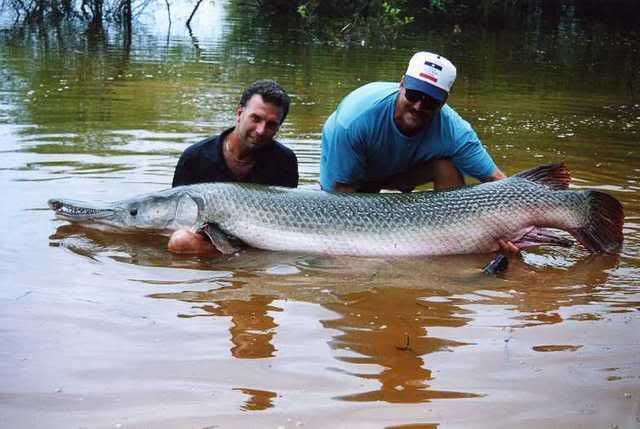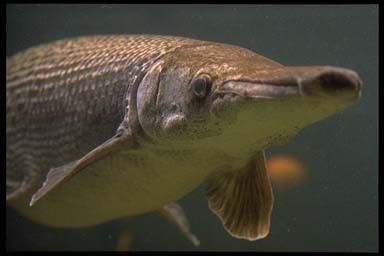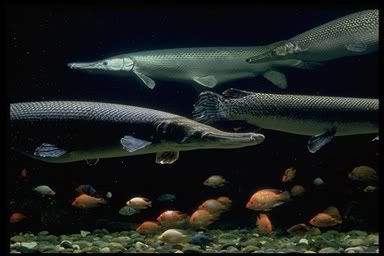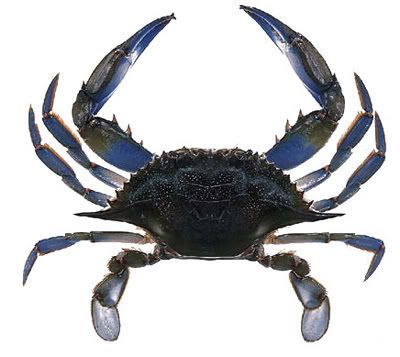 ALLIGATOR GAR
http://www.flmnh.ufl.edu/fish/Gallery/D ... orGar.html
ALLIGATOR GAR
http://www.flmnh.ufl.edu/fish/Gallery/D ... orGar.html
[The Florida Museum of Natural History]
Order - Lepisosteiformes
Family - Lepisosteidae
Genus - Atractosteus
Species - spatula

Susan Middleton © California Academy of Sciences
Taxonomy
Lacepede first described the alligator gar in 1803. The original name was Lepisosteus spatula and later changed by Wiley in 1976 to Atractosteus spatula in order to recognize two distinct extant genera of gars. The name spatula is the Latin derivative of the Greek word spathe meaning "any tool with a broad, flat blade." The genus Atractosteus is derived from the Greek word atractus, meaning "spindle" and osteus (Greek osteos) which means "bony." Synonyms of Atractosteus spatula include Lesisosteus [sic] ferox (Rafinesque 1820), and Lepisosteus spatula (Lacepede 1803). Fossils from the order Lepisosteiformes have been collected in Europe from the Cretaceous to Oligocene periods, in Africa and India from the Cretaceous, and in North America from the Cretaceous to recent. There is only one extant family of gar, Lepisosteidae, which has seven species all located in North and Central America.
Common Names
The English common name for Atractosteus spatula are alligator gar, gator, greater gar, garpike, garfish, and Mississippi alligator gar. Other common names are pejelagarto (Spanish), marjuari (Spanish), catan (Spanish, gaspar baba (Spanish), garpigue alligator (French), alligatorpansergedde (Danish), alligatorbengadda (Swedish), keihasluuhauki (Finnish), and kostlin obrovsky (Czech).
Geographical Distribution
Although fossils of gars have been found in North America, Central America, Europe, and Asia, the living members of the family are restricted to seven species living in North and Central America. Five of the seven species live in the United States. The range of the alligator gar extends from the Florida Panhandle, through the Gulf Coastal Plain and the Mississippi River Basin extending north to the lower portions of the Ohio and the Missouri River, and ranges southwest through Texas down to Veracruz, Mexico. There is a population in Mississippi Sound and the brackish water of the Gulf Coast and Mobile-Tensaw Delta that seldom stray far inland. There are also reports of a disjunct isolated population living in Nicaragua. The alligator gar is disappearing from many parts of the range, and declining in population everywhere due to over-fishing and the construction of dikes, dams, and other flood control devices, resulting in loss of key breeding habitat. The alligator gar was once reported as common and even numerous in much of its northern range. Now it is rare in the Northern parts of its range with reports of valid sightings coming in only every few years.

World distribution map for the alligator gar
Habitat
The alligator gar inhabits large, slow moving rivers, reservoirs, oxbow lakes, bayous and bays, in fresh and brackish water. The alligator gar is the most tolerant gar species of high salinity and occasionally strays into salt water. Young may be seen at the surface in debris such as leaves and twigs. Alligator gar prefer large rivers that have a large overflow floodplane, but these rivers have all but disappeared in North America due to the use of dredging, dams, dikes, and levees.
Biology

Alligator gar
Susan Middleton © California Academy of Sciences
·
Distinctive Features
All gars have an elongated, torpedo-shaped body. The caudal fin of the alligator gar is abbreviate-heterocerical, meaning the tail is not symmetrical. The dorsal and anal fins are located very far back on the body. Gars bodies are covered by ganoid scales, which are thick overlapping scales that create a protective covering similar to medieval chainmail. Gars have retained the spiral valve intestine a primitive feature of the digestive system commonly associated with sharks. Gars also have a highly vascularized swim bladder connected to the pharynx by a pneumatic duct. This enables them to gulp air, which aids in facultative air breathing. This allows gar to breathe when there are very low oxygen levels in the water. The alligator gar is distinguished from other gars in the United States by its relatively short, broad snout which has two rows of fang-like teeth in the upper jaw. The inner row of teeth in the upper jaw is palatine and larger than the outer row of teeth.

Alligator gars in an aquarium
Susan Middleton © California Academy of Sciences
·
Coloration
The alligator gar is dark olive-green dorsally, fading to yellowish white ventrally. Young alligator gars possess a light mid-dorsal stripe bordered by thin dark lines from the tip of snout to the dorsal fin, and a dark lateral band extends along the sides with irregular borders. The dorsal, anal, and caudal fins of the Alligator gar often have oval-shaped black spots. Adult specimens lack spots on the body.
·
Dentition
Alligator gars have two rows of teeth. The inner row of teeth is palatine and is longer than the outer row of teeth. The teeth of the alligator gar are long, slander, and fang like, enabling these fish to pierce and hold their prey.
·
Size, Age & Growth
The alligator gar is one of the largest freshwater fishes in North America and is the largest of the gar species. Young gars have an adhesive disc on the underside of the snout that they use to attach to objects on the bottom until the yolk sac is absorbed. Young gars also have a dorsal caudal filament at the posterior end of the upturned vertebral column, which atrophies and disappears in adults. Gars are slow growing fish, with female alligator gars reaching sexual maturity around age 11 and living to age 50. Male alligator gars mature around age 6 and live at least 26 years. Alligator gars commonly grow to a size of 6 1/2ft (2 m) and over 100 lbs. (45kg). But have been reported to grow up to 350 lbs. and around 10 ft (3m) in length. The largest recorded alligator gar comes from the St. Francis River, Arkansas in the 1930's, and weighed 350 lbs (159 kg).

Alligator gars feed on a variety of prey including blue crabs (Callinectes sapidus)
courtesy U.S. FDA
·
Food Habits
Alligator gars appear sluggish, however they are voracious predators. Gars are ambush predators, primarily piscivores, they lay still in the water until an unsuspecting fish swims by, and then lunging forward and lashing the head from side to side in order to capture prey. Many times gars will lay still at the top of the water for long periods of time, appearing to be merely a log. The alligator gars' diet consists primarily of fish. However, brackish water populations of alligator gar are known to feed heavily on blue crabs in addition to fish such as the hardhead catfish. This gar is also known to prey on waterfowl and other birds, small mammals, turtles, and carrion. Alligator gars have been reported to attack duck decoys and eat injured waterfowl shot by hunters.
·
Reproduction
Little is known of the life history of alligator gar. The gonadosomatic index for mature males and females, and female reproductive hormone analysis have indicated that spawning occurs in late spring, young specimens collected have indicated that spawning probably occurs in April, May, and June in the southern United States. Alligator gars are thought to spawn in the spring by congregating in large numbers with a female and one or more males on either side to fertilize the eggs. Fecundity in females has a positive correlation with total length. Females generally carry an average of 138,000 eggs. The eggs are released and fertilized by the male outside of the body they sink to the bottom after being released and stick to the substrate due to an adhesive outer covering. The eggs are bright red and poisonous if eaten. Alligator gars are thought to spawn in the floodplain of these large rivers, giving their young protection from predators.

American alligators are a potential predator of alligator gar
courtesy U.S. Geological Survey
·
Predators
Due to its extremely large size, an adult alligator gar has few natural predators. Young gars are preyed upon by larger fish, but once they reach a size of about 3 feet (1 m) their only natural predator would be an American alligator (Alligator mississippiensis).

This large alligator gar was just under 8 feet in length and weighed 215 pounds!
© Mike Guerin/
http://TheJump.Net
Importance to Humans
The alligator gar has been commercially fished in southern states along with other gar species, and has also been fished and bow-fished. The meat of the alligator gar has been commercially sold for over a dollar a pound locally. It is not classified as a sport fish in some states such as Texas even though there is a popular bow fishery along the Rio Grande River. It is classified as a sport fish Alabama where the limit is 2 fish per day, which makes it off limits to commercial fishing in Alabama. The alligator gars, along with other gars, are important to their ecosystem in order to maintain the ecological balance.
Danger to Humans
Due to its large size and sharp teeth, the alligator gar is capable of delivering a serious bite wound to fisherman or swimmers. However, there is no documentation of attacks on man by alligator gars. The eggs are poisonous, causing illness if consumed by humans.
 Conservation
Conservation
The alligator gar is rare, endangered, and has even been extirpated from many of the outer areas of its range. Studies in Alabama, Mississippi, and Louisiana have shown that the alligator gar is very susceptible to overfishing. It has been classified as rare in Missouri, threatened in Illinois, and endangered in Arkansas, Kentucky, and is soon to be in Tennessee.
Prepared by:
Nathaniel Goddard


















